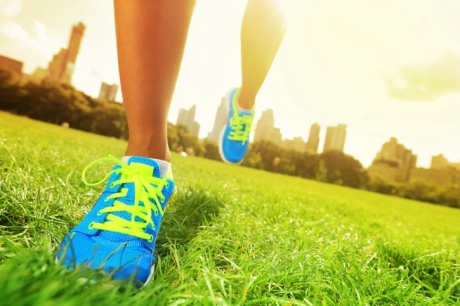Proper-fitting sports shoes can enhance performance and prevent injuries. The American Orthopaedic Foot and Ankle Society suggests these guidelines when purchasing a new pair of athletic shoes.
- If possible, purchase athletic shoes from a specialty store. The staff will provide valuable input on the type of shoe needed for your sport as well as help with proper fitting. This may cost a premium in price but is worthwhile, particularly for shoes that are used often.
- Try on athletic shoes after a workout or run, or at the end of the day. Your feet will be at their largest.
- Wear the same type of sock that you will wear for that sport.
- When the shoe is on your foot, you should be able to freely wiggle all of your toes.
- The shoes should be comfortable as soon as you try them on. There is no break-in period.
- Walk or run a few steps in your shoes. They should be comfortable.
- Always re-lace the shoes you are trying on. You should begin at the farthest eyelets and apply even pressure as you create a crisscross lacing pattern to the top of the shoe.
- There should be a firm grip of the shoe to your heel. Your heel should not slip as you walk or run.
- If you participate in a sport three or more times a week, you need a sport-specific shoe.
- It can be hard to choose from the many different types of athletic shoes available.
There are differences in design and variations in material and weight. These differences have been developed to protect the areas of the feet that encounter the most stress in a particular athletic activity.
Know Your Sport Shoes
If you play a sport three or more times per week, a sport-specific shoe may be necessary. Remember that after 300 to 500 miles of running or 300 hours of aerobic activity, the cushioning material in a shoe is usually worn down and it’s time to toss the shoes.
Many problems in the feet respond to stretching and conditioning, choosing a different shoe, and simple over-the-counter shoe modifications. However, long-term (chronic) and complicated problems of the feet may require specially designed inserts (orthoses) made of materials that concentrate relief on a particular area while supporting other areas. These conditions include severe flat foot, high arches, shin splints, Achilles tendinitis and turf toe.
To obtain the best relief for such problems, see an orthopedic surgeon, a doctor specializing in diseases of the bones and joints. The orthopedic surgeon is trained to treat problems of the foot and ankle. Working with orthopedic surgeons, pedorthists and orthotists are trained to make and modify arch supports (orthoses) and fulfill the surgeon’s prescription.
Working with these professionals will ensure you get the right shoe for the best possible treatment.

